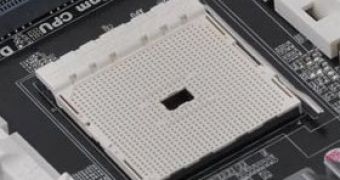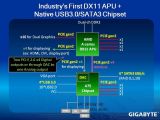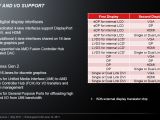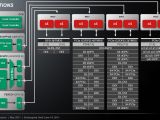Together with the desktop version of Llano, AMD will launch at the end of this months the A75 and A70 Fusion controller hubs which were specially designed to accompany these APUs, and now enough information is available for us to present you the functionality of these chipsets.
As most of you probably know, the biggest change that AMD introduced with the AMD A75 and A70 is the move towards a much simpler chipset design which drops the traditional north and south bridge setup in favor of a single controller.
This was made possible by the company's decision to move most of the functionality that is available in the north bridge to the Llano APU.
This includes the PCI Express controller, which packs 16 PCI-E Gen 2 lanes, just as it's the case with Intel's Sandy Bridge CPUs.
Also just like Sandy Bridge, these can be used for running a PCI-E x16 slot or can be split into a pair of x8 lanes for dual-GPU graphics setups.
In addition to the 16 PCI Express lanes used for graphics, AMD's Llano APUs also include a four-lane PCI-E Gen 2 controller for running four x1 slots, two x2 slots or an x4 slot (various other combinations are also possible).
The integrated graphics core found in the Llano processor die also communicates with the outside world through two four lane PCI-E interfaces.
The first one of these is used for running the digital video outputs available on the motherboard (HDMI, DVI or DisplayPort), while the latter goes into a DAC found on the PCH for running the VGA port.
It's important to note that even if the analog and video interfaces are separated, connecting a monitor to the VGA port will limit the number of displays that can be connected to the digital video outputs to just one.
The rest of the data that has to be sent back and fourth between the Llano APU and the FCH uses a so-called UMI link which is basically a fourth PCI Express x4 interface that provides 2GB/s worth of bandwidth in each direction.
On the chipset side, AMD allows motherboard makers to use this interface for driving up to four additional PCI Express x1 slots, a PCI slot as well as the four USB 3.0 and six SATA 6Gbps ports which are natively supported by the controller.
In practice, I doubt too many makers will use this for installing additional PCI Express slots, as doing so will most certainly severely limit the bandwidth available to the storage system.
Finally, we'll have to wait and see how motherboard makers will implement these chipsets in their upcoming FM1 solutions which are expected to arrive at the end of this month.

 14 DAY TRIAL //
14 DAY TRIAL // 


